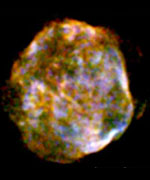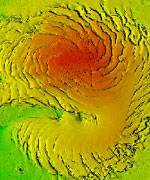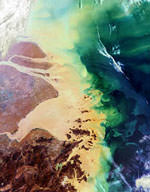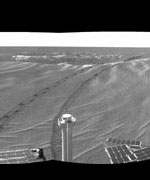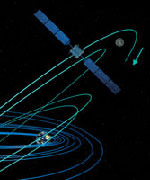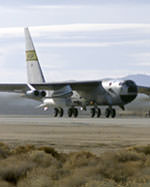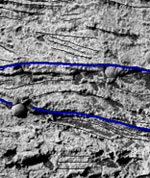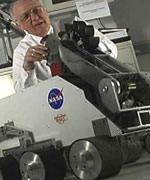
Image credit: NASA
Sludge. That’s what most people think of when they envision the gray, powdery soil ? called regolith ? covering the airless surface of the Moon. Not Dr. Mike Duke. He sees gold.
Gold in the form of rocket propellant, power, and even breathable air ? all things that will be as valuable as gold to the first Moon-dwellers.
“As a young man, I wanted to go to the Moon,” says 68-year-old Duke, who was one of the first geologists to study samples from Moon rocks collected during the Apollo missions in the 1970s. I may be too old to make the trip when Americans return to the Moon, but the research I am leading will help the first lunar settlers take what’s there and make something practical.”
Duke is an expert in what space explorers call “in-situ resource utilization” or ISRU ? living off the land of an alien world. In 2003, he was named director of the Center for Commercial Applications of Combustion in Space Centers at the Colorado School of Mines in Golden ? one of NASA’s 15 Research Partnership. He joined the partnership center in 2000 and uses skills he honed during his 25-year career as a NASA geologist. In 1965, he was a candidate for NASA’s Scientist Astronaut Program, made the finals, but wasn’t selected to fly. He went on to help other space explorers, from 1976 until 1990 as the director of the Solar System Exploration Division and from 1990 to 1995 as the chief scientist for the Human Exploration Program ? both at NASA’s Johnson Space Center in Houston.
“We can’t take everything to the Moon or Mars with us,” Duke says. “Today, it would take about 100,000 dollars to get a couple pounds of material moved from Earth to the Moon. So making propellant on the Moon would make trips back to Earth or on to Mars less expensive.”
Before you can process the lunar soil and turn it into rocket propellant or other useful materials, you have to figure out a way to mine it. For four years, Duke and a team of graduate students have been working on a robotic excavator. They built a prototype that weighs around a hundred pounds and has a chassis similar to the NASA rovers ? Spirit and Opportunity ? on Mars now. An arm-like boom extends from the vehicle’s front end. It sports a wheel of buckets that scoop up soil. The dirt falls out of the buckets and into a conveyer system that takes it up the side of the boom. The arm moves from side to side and excavates a swath of dirt one and a half feet wide, the width of the excavator.
The current model can dig up several hundred pounds of dirt in an hour, but the team is working to increase the excavation rate. They also are designing a system to shoot the dirt from the excavator to a “lunar dump truck.” The truck would carry the soil to a processing facility to extract hydrogen ? a component of the fuel that powers the Space Shuttle and could fuel a lunar rocket.
Duke and his students also have completed a model that identifies lunar resources and their potential uses. The team even examined how a company could make money on the Moon, and came up with a scenario for a “space filling station” ? where in-space tugs would be loaded with lunar-made propellants and used to boost communications satellites to high orbits.
Why is Duke concerned with space business ventures? Collaborating with industry to explore the solar system is one of the goals of the Research Partnership Centers managed by the Space Partnership Development Program at NASA’s Marshall Space Flight Center in Huntsville, Ala., for NASA’s Office of Biological and Physical Research, Washington.
“NASA’s Research Partnership Centers bring together industry, academia and government to advance exploration in space,” says Duke. “These collaborations are an effective way to create new technologies at lower costs.”
One of the aspects Duke most enjoys about his job is creating new opportunities for students to conduct original research that will help advance space exploration.
“I studied geology at Caltech because I loved California ‘s mountains and deserts,” recalls Duke, a Los Angeles native who earned his doctorate degree in 1963 from the California Institute of Technology in Pasadena. “But the university was a hotbed for planetary science, and my professors inspired me to study the geology of meteorites and the Moon. I want my students to become the next generation of scientists and engineers who take America to the Moon and beyond.”
One recent project that students helped design was the water mist investigation, conducted in space to examine how to fight fire with a fog-like mist of water ? instead of large amounts of water that can damage computers and other equipment. The STS-107 Space Shuttle crew completed the experiment during their January 2003 flight.
Although the experiment equipment was lost in the Columbia accident, the team received data from video sent back to Earth during the mission. They are using the data to design a space fire extinguisher for contained environments such as spacecraft, space habitats and submarines.
For more information visit:
Center for Commercial Applications of Combustion in Space
http://www.mines.edu/research/ccacs/
Office of Biological and Physical Research
http://spaceresearch.nasa.gov/
Space Partnership Development Program
http://www.spd.nasa.gov
Original Source: NASA News Release

